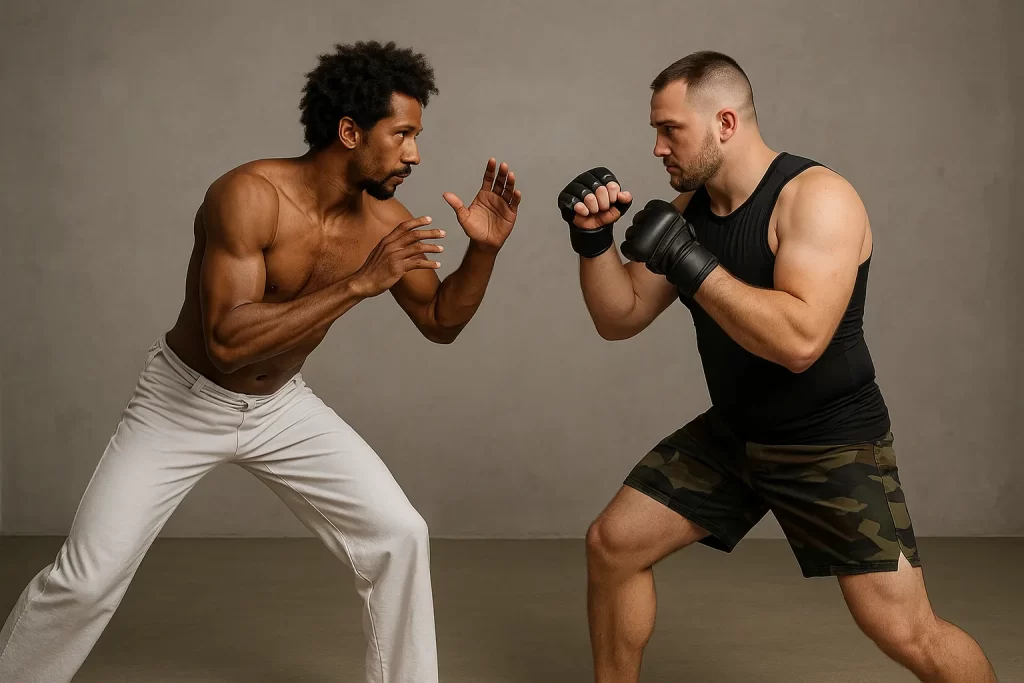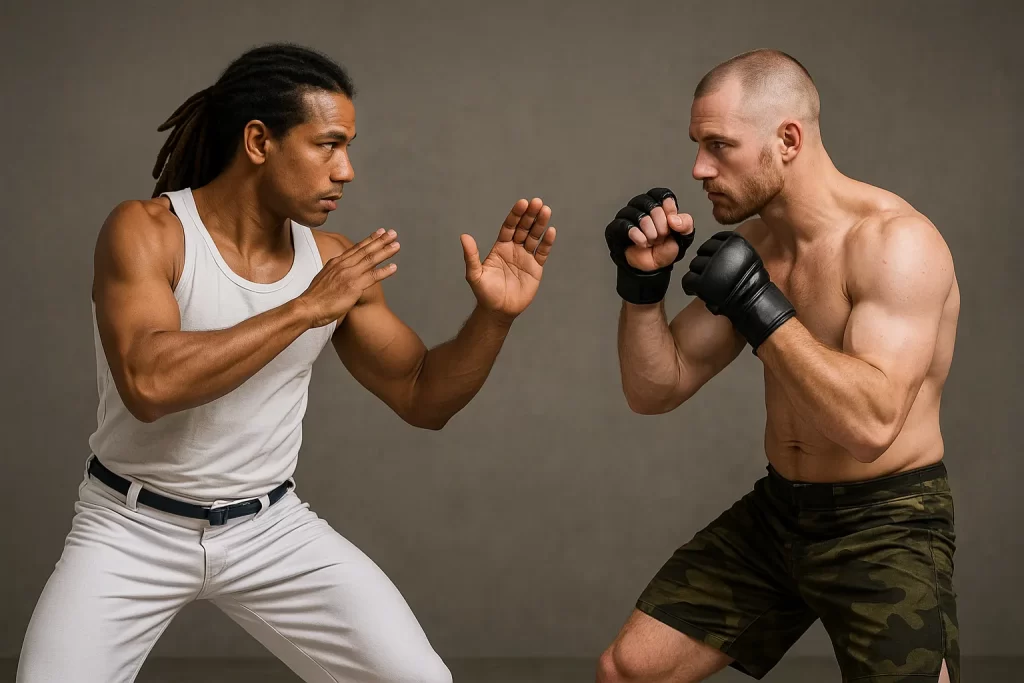The Essence of Capoeira: A Fluid Dance Between Combat and Art
Capoeira, a Brazilian martial art rooted in African heritage, is far more than acrobatic kicks and rhythmic movement. It is a tactical, improvisational discipline that balances deception, timing, and agility within a framework that often defies conventional notions of combat. At its core, Capoeira functions on circular movement, continuous motion, and the strategic use of rhythm to disorient opponents.
Combat Style: Capoeira’s fighting logic is centered around mobility, unpredictability, and avoidance rather than direct collision. A practitioner seldom attacks in a linear fashion. Instead, techniques like meia-lua de compasso (spinning kick), rabo de arraia (scorpion kick), or queda de rins (kidney fall takedown) are executed with rotational momentum, often off rhythm to deceive timing.
Training Style: Training in Capoeira includes ginga (a foundational sway), roda (ritual circle play), call-and-response music, and partner drills that simulate attack-defend-counter sequences in a game-like context. It lacks traditional sparring rounds but emphasizes reaction and flow under pressure. Exercises develop proprioception, spatial awareness, and kinetic reactivity in fluid scenarios.
Philosophy and Mindset: Capoeira is built on cunning (malícia) and playfulness (jogo), where strategy often trumps brute force. The philosophy encourages strategic humility—never confronting strength head-on but rerouting energy through movement. Symbolically and practically, it teaches that control lies in freedom of motion, not rigidity.
Real-World Usefulness: In everyday life, Capoeira enhances body intelligence and reactive instincts. The emphasis on peripheral vision and evasive motion can help with situational awareness and escape tactics in self-defense. For instance, avoiding a wrist grab by spinning under or redirecting force using evasive steps aligns with Capoeira’s kinetic philosophy.
Individual Benefits: Practitioners often report increased cardiovascular endurance, core strength, rhythmical coordination, and emotional regulation through music-led flow states. Its psychological effect—a unique mix of empowerment, stress release, and embodied freedom—makes it especially valuable in urban contexts where confrontation isn’t always physical.
Prerequisites for Training: While Capoeira is open to all fitness levels, beginners should ideally possess (or be willing to develop) spatial coordination and lower body flexibility. The entry barrier is psychological rather than physical—the willingness to express through movement, accept unpredictability, and learn through play.
The Nature of MMA: Structured Chaos and Cross-Disciplinary Combat
Mixed Martial Arts (MMA) represents the modern pinnacle of unarmed combat sports. Developed from the need to integrate techniques across disciplines—wrestling, boxing, Brazilian Jiu-Jitsu, Muay Thai, and more—MMA emphasizes measurable performance in controlled yet unpredictable fights. Unlike traditional martial arts, MMA is not a philosophical tradition but a performance-driven ecosystem.
Combat Style: MMA fighters are trained to control the fight across all phases—striking, clinch, and ground. The range of attacks includes jab-cross-hook combinations, double-leg takedowns, ground-and-pound strategies, or submission chains such as triangle chokes and rear naked chokes. Adaptability is paramount; a fighter must shift tactics instantly based on the opponent’s strengths and the fight’s progression.
Training Style: MMA training is highly modular and data-driven. It involves live sparring, positional drills, strength & conditioning, video breakdowns, and scenario-based training. For example, fighters might drill escaping from bottom mount under fatigue or transitioning from cage pressure to single-leg attacks. Everything is mapped, timed, and optimized.
Philosophy and Mindset: The philosophy of MMA is Darwinian. Efficiency and effectiveness rule. There’s little room for symbolism or ritual—everything must prove its value in competition. The mindset is competitive, resilient, and ruthlessly honest. Practitioners quickly learn what works and what doesn’t, often under public scrutiny.
Real-World Usefulness: From a purely self-defense standpoint, MMA provides an excellent toolkit—functional striking, grappling, clinch control, and the ability to manage adrenaline. However, it assumes a rules-based setting and physical parity. In unstructured environments (e.g., surprise attacks or confined spaces), some tactics may be less practical than arts specialized in evasion or escape.
Individual Benefits: MMA builds physical dominance and mental toughness. It fosters grit, consistency, tactical intelligence, and bodily efficiency. Training demands high-level cardio, power, and muscular endurance, but also game-planning and composure under pressure. Fighters often report increased discipline and self-mastery through adversity.
Prerequisites for Training: While MMA gyms welcome beginners, progress requires substantial commitment. A base in one discipline is advantageous. Due to its intensity, those with injuries, low recovery capacity, or aversion to direct confrontation may find it overwhelming. It rewards systematic thinkers who are comfortable in chaotic systems.
Summary Comparison – Foundations in Context
| Feature | Capoeira | MMA |
|---|---|---|
| Combat Logic | Evasive, deceptive, rhythm-based | Direct, adaptive, performance-driven |
| Training Focus | Flow, movement intelligence, reactive drills | Sparring, cross-discipline drills, tactical planning |
| Philosophy | Strategic play, freedom, cultural resistance | Effectiveness, adaptability, real-world testing |
| Real-Life Utility | Evasion, awareness, mobility | Physical control, combat-readiness |
| Individual Growth | Rhythm, creativity, emotional expression | Discipline, resilience, tactical thinking |
| Entry Requirements | Expressive mindset, flexibility | Physical grit, mental resilience, structured goals |

Capoeira vs. MMA in Controlled Environments: Testing Skill Within the Rules
In regulated environments such as dojos, academies, or official matches, both Capoeira and MMA offer distinct approaches to developing and applying combat skills—but with drastically different frameworks of engagement and feedback.
MMA in the Ring or Cage
MMA thrives in structured, high-pressure environments. Fighters are regularly tested in full-contact scenarios, where rules are minimal but well-enforced—no eye gouges, groin strikes, or small joint manipulation. Training mimics combat realities with timed rounds, weight classes, and strategic coaching. The feedback loop is immediate: a missed guard leads to a knockout; a poor takedown setup ends in a counter-submission.
Typical examples include:
- Striking exchanges with tight combos (jab–cross–low kick–clinch).
- Cage control drills where fighters pin opponents and land body strikes.
- Transition chains, such as moving from side control to mount and submitting via arm triangle.
These practices emphasize combat realism and condition both the body and mind to react under duress. MMA’s scientific approach to performance measurement makes it an ideal style for those who want results-driven training with objective improvement metrics.
Capoeira in the Roda
Capoeira’s equivalent of sparring occurs within the roda, a ritual circle defined by music, rhythm, and mutual awareness. While not competitive in the Western sense, it simulates real-time combat improvisation. Practitioners engage in flowing exchanges where the objective is to “outplay” rather than injure—using timing, deception, and aesthetic creativity.
Examples of live application:
- Feigning low attacks to draw reactions before launching an overhead kick.
- Spinning dodges (esquiva) to evade high linear strikes.
- Improvised sweeps from low stances to disrupt balance subtly.
Unlike MMA, Capoeira emphasizes fluidity and creativity over confrontation. There are no referees or scorecards—success is measured in one’s ability to control space and rhythm without direct aggression. This makes Capoeira a powerful tool for developing movement intelligence in lower-stakes, less adversarial environments.
Street Relevance: Real-World Application of Technique and Strategy
While both styles offer benefits for real-life self-defense, their effectiveness depends heavily on context, environment, and the practitioner’s intent.
Capoeira’s Strengths in Urban Defense
Capoeira is particularly suited for escape, evasion, and psychological de-escalation:
- In crowded or narrow environments, Capoeira’s low base and ability to spin or roll from vulnerable positions allow for evasive maneuvers without requiring space to strike.
- It develops spatial awareness, allowing practitioners to sense threats from peripheral angles.
- A practitioner might use a spinning meia-lua de compasso not as a finishing strike, but to create space and confuse multiple attackers momentarily.
Capoeira shines in non-lethal defense—especially when protecting one’s space without escalating. However, the lack of clinch control or grounded techniques may limit its utility against determined or grappling-based threats.
MMA’s Tactical Versatility in Confrontation
MMA techniques are often seen as more straightforwardly “practical”:
- A trained fighter can quickly neutralize threats with a takedown, positional control, and strikes.
- Grappling knowledge allows for subdual without permanent damage—critical in legal or social environments where excessive force is penalized.
- A rear naked choke, for example, can end a confrontation without causing visible harm.
However, MMA assumes space, clarity, and a degree of parity—factors not always present in real confrontations. In cramped environments or against multiple attackers, MMA’s linear confrontational style can become a liability, especially if the practitioner gets locked into a ground exchange.
Technique Comparison: Divergent Tools for Divergent Contexts
| Situation | Capoeira Response | MMA Response |
|---|---|---|
| Multiple attackers in a narrow alley | Use spinning kicks to distract, evasive low sweeps, roll under openings | Prioritize disengagement; avoid ground fighting; low kicks to disable movement |
| Bear hug from behind | Escape via rolling out and spinning into visual range | Hip throw counter, turn-in clinch, apply standing guillotine |
| Street argument escalating to fight | Use deceptive footwork to avoid engagement; psychologically defuse via motion | Step in, clinch to neutralize, take control of the situation |
| Grabbed by wrist | Rotate and roll wrist with rhythm, using peripheral motion to escape | Strip grip with wrist control and counterstrike or reposition |
Each style excels under specific conditions. Capoeira offers strategic chaos and ambiguity, while MMA delivers precision control and damage management.
Age Suitability: When and Why to Begin Each Discipline
Age plays a significant role in how each martial art is absorbed and applied—both physically and psychologically.
Children and Adolescents (6–17 years)
- Capoeira is ideal for young learners:
- Encourages rhythm, creativity, and physical expression.
- Builds coordination and self-confidence without contact pressure.
- Offers a cultural and musical dimension often lacking in traditional sports.
- Less injury risk due to absence of full-contact sparring.
- MMA, while increasingly available to teens, poses challenges:
- Demands discipline and resilience that may overwhelm emotionally sensitive youth.
- Striking and grappling carry injury risks, even with gear.
- Can foster early competitiveness, but requires careful supervision to prevent burnout or trauma.
Adults (18–45 years)
- Capoeira appeals to adults seeking functional fitness, stress relief, and expressive movement.
- MMA is ideal for those with athletic backgrounds or performance goals—often attracting people with clear intent to test themselves competitively or gain self-defense skills in a short period.
Mature Practitioners (45+ years)
- Capoeira can be sustained longer with proper adaptation:
- Emphasis on flow, rhythm, and flexibility remains achievable with aging.
- Less joint strain if high-impact movements are moderated.
- MMA at this stage demands careful tailoring:
- Conditioning must be measured; injury recovery is slower.
- Grappling may remain accessible, but striking intensity typically must decrease.
- It’s best suited for those with prior experience or specific self-defense goals.
Conclusion: Two Paths, One Purpose
Capoeira and MMA represent two radically different evolutions of martial thought. One is poetic and deceptive, rooted in historical resistance and cultural embodiment. The other is empirical and efficient, born of the modern sport-science crucible.
Where Capoeira teaches you to evade the fight with grace, MMA trains you to win it with precision.
Ultimately, the choice between them is less about which is “better”—and more about which style aligns with your personality, body, and goals.


